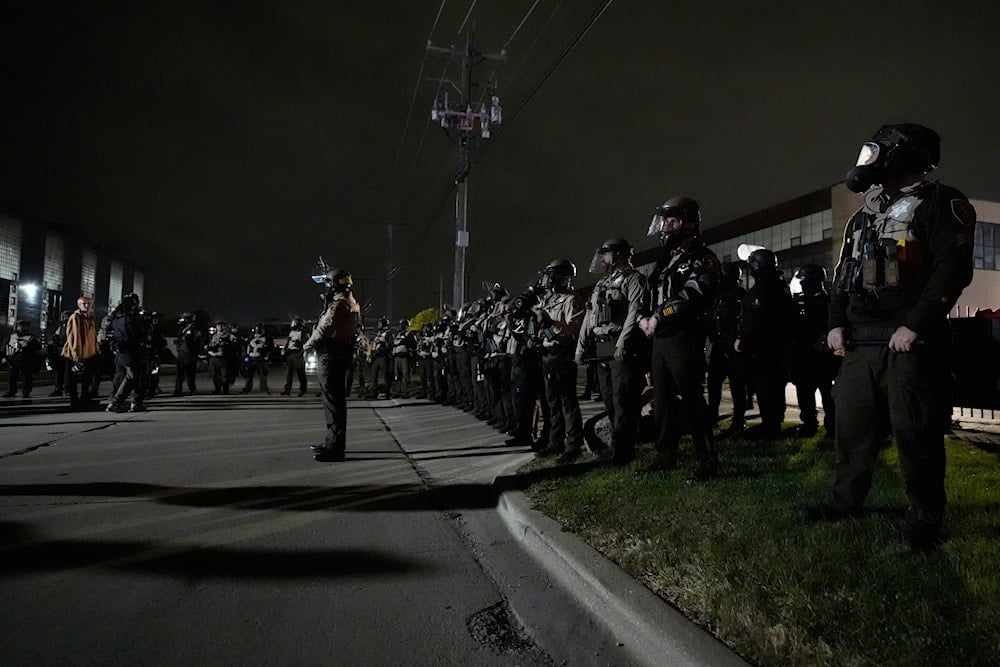US may pay private bounty hunters to track down immigrants
ICE considers hiring private bounty hunters with financial incentives to locate 1 million undocumented immigrants using skip tracing and surveillance.
-

Law enforcement standoff with protesters outside an ICE processing facility in the Chicago suburb of Broadview, Ill., Saturday, Nov. 1, 2025 (AP)
The US Immigration and Customs Enforcement (ICE) is exploring a potential initiative that would involve contracting private bounty hunters and providing them with financial incentives for finding and identifying undocumented immigrants throughout the United States.
Companies hired by ICE would be assigned bundles of information to locate 10,000 immigrants at a time, with further assignments provided in increments of 10,000 up to a total of 1,000,000 individuals, according to a procurement document reviewed by The Intercept.
The solicitation reveals that ICE is considering an "incentive-based pricing structure," which would reward contractors with monetary bonuses for achieving quick and accurate results, such as correctly locating a person's address on the first attempt or finding 90 percent of their assigned targets within a specified period.
Previously, in February, Politico reported that Erik Prince, an ally of US President Donald Trump, was advocating for the creation of a private initiative to locate immigrants and for a "bounty program which provides a cash reward for each illegal alien held by a state or local law enforcement officer."
A skip-tracing-fueled witch hunt
The proposal includes the use of "skip-tracing", a technique that relies on various data sources to locate individuals, a method that ICE is already funding through multimillion-dollar contracts, according to The Lever.
The data shared by ICE would contain government case files, location details, social media activity, and even photos or documents indicating where a person lives or works.
The plan involves both physical and digital forms of surveillance, with ICE allowing contractors to use commercially available monitoring tools for verifying immigrants’ addresses through “enhanced location research,” a process that includes real-time automated and manual skip tracing.
The new procurement document notes that "the government is contemplating awarding contracts to multiple vendors" because of the large number of immigrants whose whereabouts it seeks to confirm.
Trump's ambitious plan to deport 3,000 people a day
The crackdown on so-called immigrants has been part of Trump's campaign promise to deport individuals without immigration documentation and to close down the Mexico-US border, a goal which led his administration to set a target for ICE to arrest at least 3,000 undocumented migrants per day.
What began as a campaign slogan quickly evolved into a nationwide operation that blurred legal distinctions. Arrests have increasingly extended to individuals residing in the country legally, including lawful permanent residents, visa holders, and international students.
Many of these detentions were justified under broad or ambiguous pretexts, ranging from alleged visa irregularities to participation in pro-Palestine protests and other political demonstrations, raising alarm over the criminalization of dissent and the expansion of immigration enforcement into civic and academic spaces.
Within hours of taking office, Trump signed a series of sweeping executive orders that reshaped the nation’s immigration and border policies. Refugee flights were abruptly canceled, troops were deployed to the southern border, and federal authorities granted expanded powers to arrest individuals in or near schools, courthouses, and workplaces, areas traditionally considered off-limits for immigration enforcement.
The measures sent a chilling message to immigrant communities and signaled a return to mass deportation as a defining feature of US domestic policy, with significant repercussions for America’s global image and its commitment to human rights.

 4 Min Read
4 Min Read








